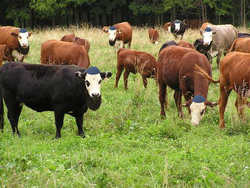Jew mignon
Jew mignon is a German delicacy believed to have been created by Pope Urban II in 1095. It is enjoyed in Germany, certain parts of the United States, Vatican City, Palestine and throughout the Middle East. It is considered by most experts to be a non-kosher dish.
The Animal[edit]
Gathering the animal[edit]
Jew mignon is a rare delicacy that can take several years to prepare after capturing one of the beasts and, as a result, in order to optimize production of this meal, it is generally considered prudent to have a large number of the creature in stock. It is generally inefficient to breed these animals in captivity, and thus males and females must be separated; as a result, it is important to maintain at least a small population present in the wild to be gathered up and domesticated later.
Transportation of the animal[edit]
Cost effective transportation of the animal is possible as well. As it is bipedal, much of its volume extends vertically and it therefore takes up little lateral space: as a result of this, efficient packing allows for several hundred to be transported by railroad at a time.
After transportation to the storage area, male and female populations should be separated. Furthermore, it is generally wise to remove certain animals generally unfit for further preparation:
- If the animal is too young, one must wait for it to mature in addition to the time one must wait for it to lose sufficient weight. As a result, it may be more cost effective to kill it rather than pay the costs required to feed it.
- If the animal is sick or disabled it will likely be incapable of doing work while being prepared and may also not be worth the end price.
Preparations of the animal[edit]
Jew mignon, despite it's world-renowned taste, is relatively economic as far as the care for the creatures go. Most experts agree that the animal should not be overfed to fatten it, but fed an absolute minimum required for it to survive. In this manner, one can assure that, although the quantity of meat left in the creature is minimal, the quality of the meat is optimal. This pays off in the end: as the dish requires years of preparation (including this step) and therefore a large quantity of animals in stock ready to be butchered and roasted, the net amount of meat produced is roughly equivalent to the amount that would result from a smaller number of creatures kept well-fed.
The intelligence of the animal suggests its cunning and desire to break free, and thus care should be taken to ensure that the animals do not escape, as this would significantly impact profit. To this effect, it is generally common practice to label each specimen with a numerical badge for cataloging. After a while they all begin to appear the same; a cataloging system allows one to quickly distinguish between animals and note if one happens to be missing.
Uses for the Animal[edit]
The animal has, on multiple occasions, shown the capacity for a moderate level of intelligence among animals and thus, while it slowly loses body mass down to the optimal quantity/quality ratio of meat, can be put to use. Studies show that it can be used for menial labor, such as work in fields, mines, factories, or other labor-intensive jobs. This is recommended, as the labor tends to help the dieting lower the body mass index of the beast. The animal can also to an extent be used for medical research similar to lab mice.
Much like the common oyster, Judaeus polskithicus is apparently capable, by some form of alchemy, of producing precious metals in small quantities in their mouths--The process is not yet fully understood by scientists, but research continues. The quantities make the effort required to extract them impractical if a herd of but one is kept (perhaps as a pet), but, as discussed above, a complete herd is generally kept, and metals such as these can therefore be extracted in surprisingly large quantities. As a side note, the animal appears to become highly agitated upon removal.
The dish[edit]
Generic preparation[edit]
The initial preparations are relatively simple:
- Care must be taken that the animal does not tense up as it dies, or the meat becomes undesirable. To this end, while shooting or hanging will suffice, using gas chambers to kill large numbers can be effective.
- Preheat oven to 420 degrees.
- Bake on Convect for 30 minutes or until of a golden brown color.
- If undesirable extremities were not removed before roasting (testicles, teeth, etc), they should
be removed.
- Bones should be removed and buried.
- The flavor of the dish can best be preserved with the use of lemon juice. Although preserved flesh carries a slightly lower price tag per pound of meat, the preserved flesh allows significant quantities of it to be kept in stock for later selling, and is therefore more likely to sell in the long run as it won't spoil.
Other variations[edit]
- The Mike Huckabee method suggests that the animals be allowed to breed, but the fetuses be aborted and prepared as another dish. The controversy regarding the abortion step means that this is not widely practiced and, as a result, Fetus mignon is considered an extremely rare delicacy that sells very well. He also suggests that homosexuals should be slaughtered immediately, as the meat is of a much lower quality.
